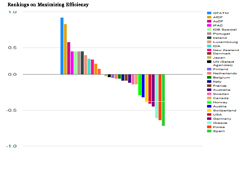
 The Center for Global Development and Brookings Institute released a new report entitled “Quality of Official Development Assistance” which explores the effectiveness of international aid to 23 separate countries and demonstrates the capacity problems U.S. development operations have experienced due to a lack of adequate resources. The donor countries’ capabilities are measured by four main indices: maximizing impact, reducing burden, fostering institutions, and transparency. Across the board, the United States performed below average, most notably in fostering institutions and reducing burden. The details of the report highlight the need for enhanced leadership capacity within U.S. aid organizations.
The Center for Global Development and Brookings Institute released a new report entitled “Quality of Official Development Assistance” which explores the effectiveness of international aid to 23 separate countries and demonstrates the capacity problems U.S. development operations have experienced due to a lack of adequate resources. The donor countries’ capabilities are measured by four main indices: maximizing impact, reducing burden, fostering institutions, and transparency. Across the board, the United States performed below average, most notably in fostering institutions and reducing burden. The details of the report highlight the need for enhanced leadership capacity within U.S. aid organizations.
The report detailed the relative strengths and weaknesses of U.S. aid, and shows the need for a “whole-of-government” approach to development. The measurements used for the paper collates the data from the sixteen different aid agencies in the U.S., and notes disparities in agency capabilities, providing insight into how overall aid from the U.S. can be better distributed worldwide.
The most successful U.S. donor organization is the Millennium Challenge Corporation (MCC), while USAID and the Defense Department scored much lower according to the reports criteria. The study explained the disparity by MCC’s lack of congressional constraints in comparison to USAID’s heavily earmarked and regulated budget as a major factor. Restoration of USAID’s independent budget authority would allow for increased autonomy and more effective distribution of aid.
One of the report’s authors, Nancy Birdsall, described the constraints to Foreign Policy’s The Cable, “Over many years, USAID has been subjected to more kinds of pressures that have made it less and less efficient, particularly on fostering institutions.” Also, as Dr. Birdsall and Homi Kharas explained on the Global Prosperity Wonkcast, USAID relies heavily on contracting to distribute aid, which tends to create a parallel system and is less likely to contribute in the medium term to developing capability.
So what can be done to improve overall effectiveness and reach of U.S. aid? If we use the criteria outlined by this report and consider some of the greatest issues with U.S. aid today, a few solutions become apparent. As mentioned, restoring USAID’s independent budget authority would more efficiently and effectively distribute aid. Also, one of the greatest problems to U.S. aid efficiency is staffing. With an expanded International Affairs budget, more positions can be filled, allowing for more effective leadership and oversight into the thousands of projects run around the world. Also, interagency cooperation will make programs more effective, reduce redundancy, and be more cost effective.
Photo Credit: Center for Global Development